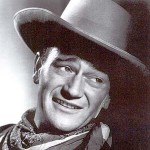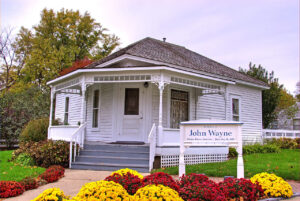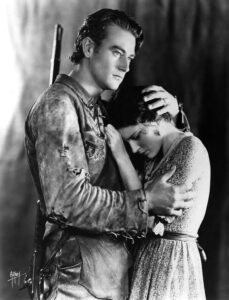john wayne

 Most people, these days, have probably never heard of Marion Robert Morrison, although I’ll bet that most people have seen at least one of his movies, or at the very least a commercial advertising one of his movies on some of the old movie channels. Maybe if I said that his name was John Wayne or even The Duke (his famous nickname), more people would recognize the famous American West actor. John Wayne actually became the epitome of the American West. Wayne was born on May 26, 1907, at 224 South Second Street in Winterset, Iowa, to Clyde Leonard Morrison (1884–1937), who was the son of American Civil War veteran Marion Mitchell Morrison (1845–1915), and the former Mary “Molly” Alberta Brown (1885–1970), who was from Lancaster County, Nebraska. He weighed a whopping 13 pounds at birth. Wayne claimed his middle name was soon changed from Robert to Michael when his parents decided to name their next son Robert. That fact, if it is a fact, cannot be confirmed even with extensive research, because no such legal change was found. Wayne’s legal name remained Marion Robert Morrison his entire life, but he often went by Marion Michael Morrison…before becoming John Wayne.
Most people, these days, have probably never heard of Marion Robert Morrison, although I’ll bet that most people have seen at least one of his movies, or at the very least a commercial advertising one of his movies on some of the old movie channels. Maybe if I said that his name was John Wayne or even The Duke (his famous nickname), more people would recognize the famous American West actor. John Wayne actually became the epitome of the American West. Wayne was born on May 26, 1907, at 224 South Second Street in Winterset, Iowa, to Clyde Leonard Morrison (1884–1937), who was the son of American Civil War veteran Marion Mitchell Morrison (1845–1915), and the former Mary “Molly” Alberta Brown (1885–1970), who was from Lancaster County, Nebraska. He weighed a whopping 13 pounds at birth. Wayne claimed his middle name was soon changed from Robert to Michael when his parents decided to name their next son Robert. That fact, if it is a fact, cannot be confirmed even with extensive research, because no such legal change was found. Wayne’s legal name remained Marion Robert Morrison his entire life, but he often went by Marion Michael Morrison…before becoming John Wayne.
When he was six years old, Wayne’s family moved to Glendale, California, where he like many teens in those days, had a paper route that got him up at four in the morning to deliver newspapers. After school, he played football and made deliveries for local stores. After high school, he had big ambitions to attend the U.S. Naval Academy, but his dreams were dashed when they rejected him. Then, he accepted a full scholarship to play football at the University of Southern California in Los Angeles, which is quite likely the very thing that led to his entire future, and not in football or academics.
For most football players, having a job isn’t an easy feat, because of the football and study schedules, so in the summer of 1926, Wayne’s football coach found him a job as an assistant prop man on the set of a movie directed by John Ford. Ford saw something more is the handsome young football player, and he started to use Wayne as an extra in his films. It’s strange, maybe, that I think that John Wayne became more handsome as he got older. The younger verson, while handsome, lacked the character that really defines some men. That led to larger roles, and in 1930, Ford recommended John Wayne for Fox’s epic Western, “The Big Trail.” Wayne won the part, but the movie did poorly, and Fox let his contract lapse. That didn’t deter John Wayne, who had by then been bitten by the acting bug. Over the next decade, he worked tirelessly on a number of low-budget films, to improve his acting abilities, and in the end, his old friend and mentor, John Ford gave him his big break, when he cast him in the 1939 western, “Stagecoach.” The rest is history, as John Wayne starred in more than 77 movies. Including my favorites, “Maclintock,” “True Grit,” “The Sons of Katie Elder,” and “Hell Fighters.” While John Wayne got his start in Westerns, he also did a number of military movies. It wasn’t hard to transition from a valiant cowboy or cavalry soldier to the brave WWII fighters of films like Sands of Iwo Jima (1949) and Flying Leathernecks (1951). John Wayne was deeply conservative in his politics, and he used his 1968 film, The Green Berets, to express his support of the American government’s war in Vietnam.
Unfortunately, by the late 1960s, some Americans had tired of Wayne and his simplistically masculine and patriotic characters. I simply cannot understand that at all, except that people had started to look for the increasingly sinister in movies. Sadly, western movies began rejecting the simple black-and-white moral codes championed by Wayne and replacing them with a more complex and tragic view of the American West…not a good move for the people. Nevertheless, John Wayne proved more adaptable than many expected. True Grit 
 (1969) allowed him to escape the narrow confines of his own good-guy image, but still remain basically “the good guy” in reality. Nevertheless, John Wayne was entering the final years of his life, whether he knew it or not. His final film, The Shootist (1976), proved once and for all that he was an actor who had earned the right to be called elite, when he won over even his most severe critics. At the time of the filming of “The Shootist,” John Wayne was battling lung cancer, while playing the part of a dying gunfighter whose moral codes and principles no longer fit in a changing world. Three years later, Wayne died of cancer. To this day, public polls identify him as one of the most popular actors of all time.
(1969) allowed him to escape the narrow confines of his own good-guy image, but still remain basically “the good guy” in reality. Nevertheless, John Wayne was entering the final years of his life, whether he knew it or not. His final film, The Shootist (1976), proved once and for all that he was an actor who had earned the right to be called elite, when he won over even his most severe critics. At the time of the filming of “The Shootist,” John Wayne was battling lung cancer, while playing the part of a dying gunfighter whose moral codes and principles no longer fit in a changing world. Three years later, Wayne died of cancer. To this day, public polls identify him as one of the most popular actors of all time.
 When I think of movie icons, one name stands out above so many others…John Wayne. From the time I was a kid, we watched a lot of John Wayne movies in our house. It was a different time then. Westerns were on the television sets of most homes. And among Westerns, John Wayne was the King of the Cowboys. I have watched every one of his Westerns, and most of his other movies, because I just always liked John Wayne…all of our family did.
When I think of movie icons, one name stands out above so many others…John Wayne. From the time I was a kid, we watched a lot of John Wayne movies in our house. It was a different time then. Westerns were on the television sets of most homes. And among Westerns, John Wayne was the King of the Cowboys. I have watched every one of his Westerns, and most of his other movies, because I just always liked John Wayne…all of our family did.
We were so excited when John Wayne came to Casper, Wyoming for the filming of “Hellfighters” in 1968. My parents were never star struck type of people, but when it came to John Wayne’s movie being filmed partly in Casper…well, that was something entirely different. They took the family…minus me unfortunately, because I was at a slumber party…to the airport to see him come in. It was a really big deal for our little town, but even more so for my sister, Cheryl. John Wayne has always been a big hero to Cheryl, and at fourteen years of age, she was so excited to finally have the opportunity to meet him. When her chance came, however, she couldn’t seem to speak loudly enough for him to hear her. Finally in a last ditch effort, she pulled on his jacket…because she couldn’t reach his shoulder to tap him on it. She said, “Mr Wayne…Mr Wayne.” When he felt that tug on his jacket, he turned around, and was a little bewildered for a moment, then he looked down at Cheryl and said, “Oh!! There you are!!” She was so short, that he had completely missed her. She got his autograph, and I found myself really wishing I had just skipped that slumber party…ever since that day. My parents also took us out to the highway where you could see the actual filming taking place across the river. It was amazing, but in my mind, nothing like the opportunity my sister got to actually meet this amazing actor.
John Wayne passed away on June 11, 1979, and I can still see that moment quite clearly. I  was at my in-laws house, and we were all watching television, when the bulletin flashed across the screen. It felt almost like being kicked in the stomach. I couldn’t believe it was real, because John Wayne had been so much a pert of my life, that he was almost like family, and now there would be no more new movies with John Wayne. A great actor was gone. I know that all of my family felt the same way, as well as a lot of other people. I felt like television had reached a turning point, and it wasn’t a good thing. I think I was right in that too, because most of the shows and movies of today don’t even come close to being the classy kinds of shows of the John Wayne Era. Those days are gone forever, like actors of the class and caliber of John Wayne.
was at my in-laws house, and we were all watching television, when the bulletin flashed across the screen. It felt almost like being kicked in the stomach. I couldn’t believe it was real, because John Wayne had been so much a pert of my life, that he was almost like family, and now there would be no more new movies with John Wayne. A great actor was gone. I know that all of my family felt the same way, as well as a lot of other people. I felt like television had reached a turning point, and it wasn’t a good thing. I think I was right in that too, because most of the shows and movies of today don’t even come close to being the classy kinds of shows of the John Wayne Era. Those days are gone forever, like actors of the class and caliber of John Wayne.

